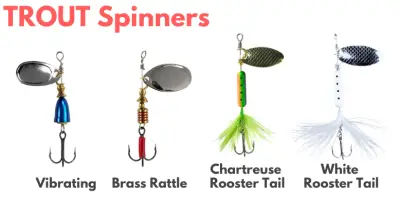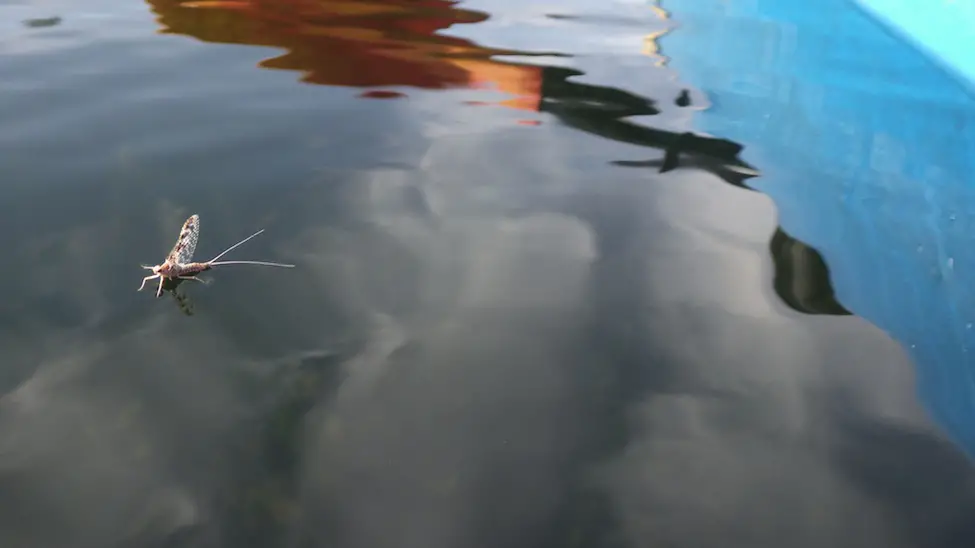The first fish most kids like me ever caught was a trout after the lake or neighborhood stream has been stocked by the State Fish & Wildlife who have farmed them in tanks feeding them a stable of fish and vitamins mixed together into pellet form of food but native trout must rely on their own for food source from where they live. What is the Best Trout Bait for Native Trout?
Native Trout are adapted to their environment from the first day until their last day they do this by eating what’s available as they mature in their environment like:
- Aquatic macroinvertebrate-being larval or nymphal forms
- Worms
- Stonefly-Mayfly
- Crayfish
- Leech
- Dragonflies
- Caddisflies,
- Beetles-midges,
Native trout eat a variety of foods including aquatic insects, fish eggs, terrestrial insects, and other foods. They are predominately carnivores and some of the food items that are most important to trout are aquatic insects that spend most of their life cycles underwater in rivers, streams, and stillwaters.
Best Trout Bait for Native Trout
Wild Trout are born in a particular waterbody and live there most of their entire life. They are considered a Native Trout and weren’t introduced by humans to the place where they live. Native Trout are adapted to their environment and have to take care of themselves from the first day until their last day.
They eat insects and macroinvertebrates, graduating to bigger feed as they grow. Stocked trout, on the other hand, spend the first couple of years of their lives living in ponds and tanks where they are fed daily before being planted or stocked in lakes, ponds, and streams.
So, even though their taste will adapt to natural trout fare, in the early days of the season, hatchery trout will eat most often almost anything. This isn’t always the case, but it does seem the spirit of competition from the hatchery pond environment stays alive in these trout.
Worms are the best trout bait overall for a few important reasons. First is that wild trout eat insects on the water more than anything else, and live worms look very similar to the grubs that trout are so accustomed to seeing.
The second is simply size. Trout are opportunistic feeders and will search out for the food source that provides the biggest bang for the bite. As long as it looks legit, trout are inclined to pick a big chunk of worm over a mayfly larva because it’s easier to see in fast-moving streams.
Matching the local forage is a principle as old as fishing itself. Before selecting a bait, take a moment to understand what the Trout in your chosen location is feeding on.
In freshwater streams, insects such as mayflies, caddisflies, and stoneflies often form a significant portion of a Trout’s diet. In larger bodies of water like lakes and reservoirs, baitfish such as minnows or small chubs can be the go-to meal.
Live Insects
Live Worms
For most trout in most situations, anglers prefer live worms over artificial ones. As long as they’re rigged right, their live wiggling moving action is hard to beat. But there are different types of live worms, and it all depends on the situation.
In streams with brown trout or big rainbows, big chunks of nightcrawlers are the way to go. I don’t mean to use the whole 10-inch worm. Cutting it down to around 4 inches still provides enough food to attract big fish, but isn’t so big that it becomes intimidating.
Fish Eggs
though they’re more popular as salmon bait than trout bait, fish eggs are undeniably some of the best bait for catching trout. Like any wild animal or fish, trout love to eat anything easy to grab and full of nutrients.
Trout eggs during the spawning season, become a major food for trout. You can take advantage of this even outside of spawning season by using real eggs and even fake eggs; either one can be killer bait when presented naturally.
Leeches
Leeches aren’t found everywhere, but where they are found they’re a favorite trout food source. That makes them great trout food, but you’ll need to check if they’re allowed before fishing with them. Regulations vary greatly depending on the state permit laws you’re fishing in because live bait like leeches can be harmful to places where they’re not native.
Crayfish
As mean and aggressive as crayfish can be (also called “crawdads”), they make great trout bait. All predatory fish love to eat crayfish, and you’d probably be surprised to see just how many of these types of natural bait end up in a trout’s stomach.
Where you can fish them, bottom bouncing the bait works best. Hook it through the end of the tail with a size 6 or 8 octopus hook and slowly drift it downriver. When fishing for trout, small crayfish only a couple of inches in size long work best.
Minnow
As great as lures and fly lines are as bait, you can’t beat the live natural bait food source for trout. One of the tastiest snacks for trout is minnows. The larger trout gobble them down like candy. Not many anglers use minnows as bait, but if you’re after the trophy trout, minnows are your go-to bait.
Tips for Choosing Trout Bait:
- Local Knowledge: Consult local anglers or bait shops for insights on what works best in specific areas.
- Match the Hatch: Observe the local insect life and choose bait that mimics what trout are naturally feeding on.
- Weather and Water Conditions: Adjust your bait choice based on water clarity, temperature, and weather conditions.
What is the Best Trout Bait For Stocked Trout?
Baits:
Wax worms
Red worms
Nightcrawlers
Salmon eggs
Powerbait- the #1 choice for catching stocked trout fed from pellets
Corn-old hands in the trout business swear by it
Minnows- It doesn’t take long for stocked trout to acclimate to their new environment .…………………………………………………………………….. Read more
Trout Spinners and Lures
Spinners are excellent lures for covering lots of water areas in search of trout. They have been around a very long time and have proven themselves to be one of the best lures for trout many times over. To use them effectively, cast and reel them in quickly enough for the blades to spin.
The trout’s highest color sensitivity is blue, after red the least sensitivity is green. Red appears brighter to trout than to humans but then quickly becomes black with distance. Fluorescent lure materials are great trout attractors in clear, deep water in low-light situations but not in stained water where UV light is scattered.
Choosing the right color for your trout lures is crucial for successful fishing. The key is to match the lure color to the water clarity and light conditions. In clear water, natural colors like silver, gold, and white are highly effective as they mimic the appearance of small baitfish and insects, which are primary food sources for trout.
These colors reflect light and create a subtle flash that attracts trout without spooking them.
In murkier water or low-light conditions, brighter and more vibrant colors like chartreuse, orange, and fluorescent shades become more visible and stand out better, making them easier for trout to spot. Additionally, consider the local forage—if the water is home to a lot of a particular type of prey, selecting a lure color that matches this prey can increase your chances of success. Experimenting with different colors and observing which ones yield the best results in specific conditions can help refine your lure selection strategy over time.

Trout spinners and lures are essential tools for any angler aiming to catch native trout. Spinners, such as the classic Mepps or Rooster Tail, feature a metal blade that spins around a central axis, creating vibrations and reflections that mimic the movement of small prey fish.
What size spinner should I use for trout?
- The size of the spinner should correspond to the size of the trout you are targeting and the water conditions. Smaller spinners (1/16 to 1/8 ounce) are ideal for smaller streams and smaller trout, while larger spinners (1/4 to 1/2 ounce) are suitable for bigger rivers and lakes where larger trout reside.
These vibrations attract trout by triggering their predatory instincts, making spinners highly effective in clear, fast-moving streams where trout rely on their keen eyesight and sense of vibration to locate food.
On the other hand, spoons, like the Kastmaster or Daredevle, are curved, spoon-shaped metal lures that wobble and flash as they move through the water, imitating injured baitfish. This action can be particularly effective in deep lakes and reservoirs where trout may be feeding on smaller fish. Both spinners and spoons are versatile and can be used in various water conditions, making them indispensable in an angler’s tackle box for targeting native trout.
Conclusion:
Choosing the right trout lure, whether it’s a spinner, spoon, or other type, involves considering various factors such as water clarity, local forage, and the specific behavior of trout in your fishing area.
By understanding and adapting to these elements, you can significantly enhance your fishing experience and increase your chances of a successful catch.
Whether you’re using natural colors in clear waters or bright hues in murky conditions, experimenting with different lures and observing the trout’s responses will help you develop an effective strategy. Armed with the right knowledge and tools, you’re well-equipped to enjoy the rewarding pursuit of trout fishing.
How Do You Tell the Difference Between Species of Trout?
3 primary species of trout:
Brown Trout-brownish-yellow color-scattered black, red,& orange spots on their sides-12″ long or less
Brook Trout-(Speckled trout) brown with reddish fins & white tips-8″ long or less
Rainbow Trout-dark back & white belly-pink stripe down middle-up to 12″ long are common .……………………………………………………………………….. Read more

References:
Fishing Booker-Best Bait for Trout: An Angler’s Guide
FAQ’s


